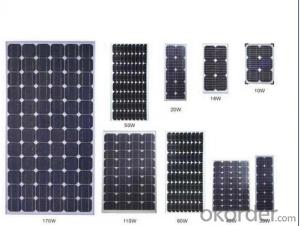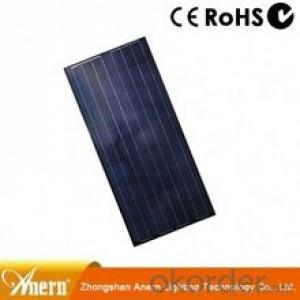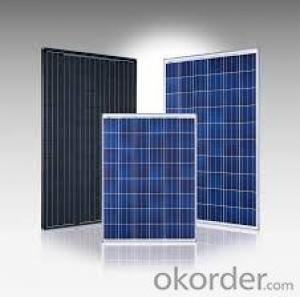Monocrystalline Solar Cell Price with 25 Year Warranty CNBM
- Loading Port:
- Qingdao
- Payment Terms:
- TT OR LC
- Min Order Qty:
- 10 pc
- Supply Capability:
- 300000 pc/month
OKorder Service Pledge
OKorder Financial Service
You Might Also Like
Quick Details
| Place of Origin: | China (Mainland) | Brand Name: | cnbm | Model Number: | PS-M672300 |
| Material: | Monocrystalline Silicon | Size: | 1956*990*40mm | Number of Cells: | 72 pieces |
| Max. Power: | 300W | Weight: | 23kg monocrystalline solar panel | Product warranty: | 25 years |
| Maximum system voltage: | 1000VDC | Tolerance: | 0/+3% | Cable length: | 1.2m |
| Connector: | MC4 compatible connector | Junction box: | IP65 Rated | Frame: | Anodized aluminium alloy |
| Front Cover: | 3.2mm thick.low iron tempered glass | Cell type: | Monocrystalline solar panel cells 156mm |
Packaging & Delivery
| Packaging Detail: | Monocrystalline solar panel packing information 28pcs. / box 20pcs. / pallet 560 pcs. / 40ft 602 pcs. / 40ft (H) |
| Delivery Detail: | in one week |
Specifications
1. Best monocrystalline solar cell price
2. 300W Monocrystalline solar panel with best price
3. 25 years warranty
Product Name
High Efficiency monocrystalline solar cell price with 25 year warranty
Product Description
1.Solar Panel Descprition
PS-M672 Series solar panel is connected in series by 70 pieces of 156mm×156mm Mono Crystalline silicon cells. Solar panel performance is produced according to IEC61215, IEC61730 international standard.
2.Solar Panel Characteristics
1)Manufactured according to international quality and Environment Management
System (ISO9001, ISO14001)
2)High efficiency crystalline silicon solar cells
3)High transmission Iow iron tempered glass, strong mechanical resistance
4)Anti-ageing EVA and excellent anti-climate back sheet
5)Anodized aluminum frame improves load resistance capabilities for heavy wind loads.
6)Standard waterproof junction box
7)High endurance to different weather
8)Good and friendly package with less transportation and storage space.
3.Solar Panel Warranty
1)10 years limited manufacturing warranty
2)10 years for 90% of warranted minimum power
3)25 years for 80% of warranted minimum power
4.Solar Panel Electric Characteristics
| Cell Type | Mono Solar Cell 156mm*156mm | |||
| Item | PS-M672285 | PS-M672290 | PS-M672295 | PS-M672300 |
| Power | 285W | 290W | 295W | 300W |
| Voc(V) | 44.8 | 45 | 45.3 | 345.5 |
| Isc(I) | 8.6 | 8.75 | 8.85 | 8.95 |
| Vm(V) | 36.2 | 36.3 | 36.5 | 36.6 |
| Im(I) | 7.87 | 7.99 | 8.08 | 8.20 |
| Cell Efficiency | 17.08 | 17.38 | 17.68 | 17.98 |
| Module Efficiency | 14.72 | 14.98 | 15.23 | 15.49 |
| Fuse | 15A | |||
| Max System Voltage | 1000VDC | |||
| Cell Number | 72cells | |||
| Tolerance | 0/+3% | |||
| Module Size | 1956*990*40(mm) | |||
| Weight | 23KGS | |||
| Cable Length | 0.9m | |||
| Connector | MC4 or compatible connector | |||

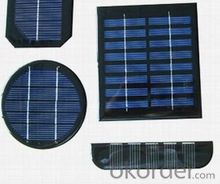
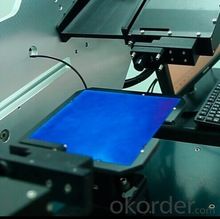
- Q:How do solar cells impact the local economy?
- Solar cells have a positive impact on the local economy as they create jobs, stimulate investment, and reduce energy costs. The installation, maintenance, and manufacturing of solar cells require skilled labor, thus creating employment opportunities within the community. Additionally, the growth of the solar industry attracts investments in infrastructure and research, fostering economic development. Moreover, solar energy helps lower electricity bills for businesses and households, freeing up funds that can be spent on other local goods and services, thereby boosting economic activity.
- Q:What is the role of tracking systems in maximizing solar cell efficiency?
- Tracking systems play a crucial role in maximizing solar cell efficiency by continuously adjusting the position of solar panels to optimize their exposure to sunlight. These systems enable solar panels to track and follow the sun's path throughout the day, ensuring that they are always facing directly towards the sun. By doing so, tracking systems can enhance the amount of sunlight captured by solar cells, resulting in increased energy production and overall efficiency.
- Q:How do solar cells perform in areas with limited sunlight?
- Solar cells do not perform as efficiently in areas with limited sunlight, as their energy production is directly dependent on the amount of sunlight available. However, advancements in solar cell technology have improved their ability to generate electricity even in low light conditions.
- Q:Can solar cells be used in powering communication networks?
- Yes, solar cells can be used to power communication networks. Solar cells convert sunlight into electricity, which can then be used to power various devices and systems, including communication networks. This makes solar energy an environmentally friendly and sustainable option for powering these networks, especially in remote or off-grid locations where access to traditional power sources may be limited.
- Q:What is the effect of shading on solar cell performance?
- The effect of shading on solar cell performance is significant as it can substantially reduce the overall power output of the solar panel. When even a small portion of the solar cell is shaded, it creates a bottleneck for the flow of current, which can lead to a decrease in the voltage and current output. Shading can cause hotspots to form on the shaded cells, resulting in potential damage or reduced efficiency. Therefore, it is crucial to minimize shading on solar panels to maximize their performance and overall energy generation.
- Q:How much maintenance do solar cells require?
- Solar cells require very little maintenance. They are designed to be durable and can typically last for decades with minimal upkeep. Routine maintenance may involve occasional cleaning to remove dust or debris that could affect their performance. Additionally, regular monitoring of the system's performance and checking for any potential issues is recommended. However, overall, solar cells are known for their low maintenance requirements, making them a reliable and cost-effective renewable energy solution.
- Q:Can solar cells be used in water purification systems?
- Yes, solar cells can be used in water purification systems. Solar cells can generate electricity from sunlight, which can be used to power various components of water purification systems, such as pumps, filters, and disinfection devices. This allows for sustainable and environmentally-friendly water purification solutions, especially in areas with limited access to electricity grids.
- Q:Can solar cells be used to charge electric vehicles?
- Yes, solar cells can be used to charge electric vehicles. Solar panels can convert sunlight into electricity, which can then be used to charge the batteries of electric vehicles. This process, known as solar charging or solar-powered charging, is an environmentally friendly and sustainable way to power electric vehicles.
- Q:How do monocrystalline solar cells differ from polycrystalline solar cells?
- Monocrystalline solar cells are made from a single crystal structure, resulting in a uniform dark color and higher efficiency. On the other hand, polycrystalline solar cells are made from multiple crystal structures, giving them a speckled appearance and slightly lower efficiency.
- Q:Can solar cells be used for powering agricultural irrigation systems?
- Yes, solar cells can be used for powering agricultural irrigation systems. Solar energy can be harnessed by installing solar panels that convert sunlight into electricity, which can then be used to power pumps and other equipment necessary for irrigation. This renewable energy source offers a sustainable and cost-effective solution for powering agricultural practices, especially in areas with limited access to electricity.
1. Manufacturer Overview |
|
|---|---|
| Location | |
| Year Established | |
| Annual Output Value | |
| Main Markets | |
| Company Certifications | |
2. Manufacturer Certificates |
|
|---|---|
| a) Certification Name | |
| Range | |
| Reference | |
| Validity Period | |
3. Manufacturer Capability |
|
|---|---|
| a)Trade Capacity | |
| Nearest Port | |
| Export Percentage | |
| No.of Employees in Trade Department | |
| Language Spoken: | |
| b)Factory Information | |
| Factory Size: | |
| No. of Production Lines | |
| Contract Manufacturing | |
| Product Price Range | |
Send your message to us
Monocrystalline Solar Cell Price with 25 Year Warranty CNBM
- Loading Port:
- Qingdao
- Payment Terms:
- TT OR LC
- Min Order Qty:
- 10 pc
- Supply Capability:
- 300000 pc/month
OKorder Service Pledge
OKorder Financial Service
Similar products
New products
Hot products
Hot Searches
Related keywords
